Seroprevalence and Risk Factors for Q fever (Coxiella burnetii) Exposure in Smallholder Dairy Cattle in Tanzania
Abstract
Simple Summary
Abstract
1. Introduction
2. Materials and Methods
2.1. Study Area
2.2. Study Design
2.3. Data Collection
2.4. Serological Analysis
2.5. Statistical Analysis
2.6. Ethical Clearance
3. Results
3.1. Information Related to Dairy Cattle
3.2. Univariable Analysis for C. burnetii Seropositivity
3.3. Multivariable Mixed Effects Logistic Regression Model for C. burnetii Seropositivity
4. Discussion
5. Conclusions
Author Contributions
Funding
Institutional Review Board Statement
Informed Consent Statement
Data Availability Statement
Acknowledgments
Conflicts of Interest
References
- WHO-FAO-OIE. Report of the WHO/FAO/OIE Joint Consultation on in Collaboration with the Health Council of the Netherlands. May 2004, pp. 1–72. Available online: http://apps.who.int/iris/bitstream/10665/68899/1/WHO_CDS_CPE_ZFK_2004.9.pdf (accessed on 15 January 2022).
- WHO. Health Aspects of Chemical and Biological weapons [Internet]. 1970. Available online: http://apps.who.int/iris/bitstream/handle/10665/39444/24039.pdf;jsessionid=70C7808FC223D73879EF96039F797E58?sequence=1 (accessed on 22 January 2022).
- Bielawska-Drózd, A.; Cieslik, P.; Mirski, T.; Bartoszcze, M.; Knap, J.P.; Gawel, J.; Zakowska, D. Q fever—selected issues. Ann. Agric. Environ. Med. 2013, 20, 222–232. [Google Scholar] [PubMed]
- ILRI. Mapping of poverty and likely zoonoses hotspots [Internet]. 2012. Available online: https://cgspace.cgiar.org/bitstream/handle/10568/21161/ZooMap_July2012_final.pdf (accessed on 22 July 2022).
- Miceli, M.H.; Veryser, A.K.; Anderson, A.D.; Hofinger, D.; Lee, S.A.; Tancik, C. A case of person-to-person transmission of Q fever from an active duty serviceman to his spouse. Vector-Borne Zoonotic Dis. 2010, 10, 539–541. [Google Scholar] [CrossRef] [PubMed]
- Tesfaye, A.; Sahele, M.; Sori, T.; Guyassa, C.; Garoma, A. Seroprevalence and associated risk factors for chlamydiosis, coxiellosis and brucellosis in sheep and goats in Borana pastoral area, southern Ethiopia. BMC Vet. Res. 2020, 16, 145. [Google Scholar] [CrossRef] [PubMed]
- Coleman, S.A.; Fischer, E.R.; Howe, D.; Mead, D.J.; Heinzen, R.A. Temporal analysis of Coxiella burnetii morphological differentiation. J. Bacteriol. 2004, 186, 7344–7352. [Google Scholar] [CrossRef] [PubMed]
- ECDC. Risk Assessment on Q Fever [Internet]. 2010. Available online: https://www.ecdc.europa.eu/sites/default/files/media/en/publications/Publications/1005_TER_Risk_Assessment_Qfever.pdf (accessed on 25 November 2021).
- CFSPH. The Center for Food Security and Public Health, Institute for International Cooperation in Animal Biologics, Lowa State University, OIE and USDA: Q Fever, Query Fever, Coxiellosis, Abattoir Fever [Internet]. 2017. Available online: https://www.cfsph.iastate.edu/Factsheets/pdfs/q_fever.pdf (accessed on 22 September 2021).
- Khamesipour, F.; Dida, G.O.; Anyona, D.N.; Razavi, M.; Rakhshandehroo, E. Tick-borne zoonoses in the Order Rickettsiales and Legionellales in Iran: A systematic review. PloS Negl. Trop. Dis. 2018, 36, e0006722. [Google Scholar] [CrossRef]
- Oboge, H. An Evaluation of Knowledge, Perceptions and Socio-Economic Aspects of Q Fever Infection in a Pastoralist Systemof Kajiado County, in Kenya. Ph.D. Thesis, University of Nairobi, Nairobi, Kenya, 2018. [Google Scholar]
- Prabhu, M.; Nicholson, W.L.; Roche, A.J.; Kersh, G.J.; Fitzpatrick, K.A.; Oliver, L.D.; Massung, R.F.; Morrissey, A.B.; Bartlett, J.A.; Onyango, J.J.; et al. MAJOR ARTICLE Q Fever, Spotted Fever Group, and Typhus Group Rickettsioses Among Hospitalized Febrile Patients in Northern Tanzania. Clin. Infect. Dis. 2011, 53, 1–8. Available online: https://www.ncbi.nlm.nih.gov/pmc/articles/PMC3148261/ (accessed on 26 July 2019). [CrossRef]
- Knobel, D.L.; Maina, A.N.; Cutler, S.J.; Ogola, E.; Feikin, D.R.; Junghae, M.; Halliday, J.E.; Richards, A.L.; Breiman, R.F.; Cleaveland, S.; et al. Coxiella burnetii in humans, domestic ruminants, and ticks in rural Western Kenya. Am. J. Trop. Med. Hyg. 2013, 88, 513–518. [Google Scholar] [CrossRef]
- Eldin, C.; Mélenotte, C.; Mediannikov, O.; Ghigo, E.; Million, M.; Edouard, S.; Mege, J.L.; Maurin, M.; Raoult, D. From Q fever to Coxiella burnetii infection: A paradigm change. Clin. Microbiol. Rev. 2017, 30, 115–190. [Google Scholar] [CrossRef]
- Guatteo, R.; Beaudeau, F.; Berri, M.; Rodolakis, A.; Jolyc, A.; Seegers, H. Shedding routes of Coxiella burnetii in dairy cows: Implications for detection and control. Vet. Res. 2006, 37, 827–833. [Google Scholar] [CrossRef] [PubMed]
- Almogren, A.; Shakoor, Z.; Hasanato, R.; Hussein Adam, M. Q fever: A neglected zoonosis in Saudi Arabia. Ann. Saudi Med. 2013, 33, 464–468. [Google Scholar] [CrossRef]
- Knap, N.; Žele, D.; Glinšek Biškup, U.; Avšič-Županc, T.; Vengušt, G. The prevalence of Coxiella burnetii in ticks and animals in Slovenia. BMC Vet. Res. 2019, 15, 4–9. [Google Scholar] [CrossRef] [PubMed]
- Wardrop, N.A.; Thomas, L.F.; Cook, E.A.; de Glanville, W.A.; Atkinson, P.M.; Wamae, C.N.; Fevre, E.M. The Sero-epidemiology of Coxiella burnetii in Humans and Cattle, Western Kenya: Evidence from a Cross-Sectional Study. PLoS Negl. Trop. Dis. 2016, 10, 1–17. [Google Scholar] [CrossRef] [PubMed]
- Körner, S.; Makert, G.R.; Mertens-Scholz, K.; Henning, K.; Pfeffer, M.; Starke, A.; Nijhof, A.M.; Ulbert, S. Uptake and fecal excretion of Coxiella burnetii by Ixodes ricinus and Dermacentor marginatus ticks. Parasites Vectors 2020, 13, 1–11. [Google Scholar] [CrossRef] [PubMed]
- Dorko, E.; Rimárová, K.; Pilipčinec, E. Influence of the environment and occupational exposure on the occurrence of Q fever. Cent. Eur. J. Public Health 2012, 20, 208–214. [Google Scholar] [CrossRef] [PubMed]
- Ratmanov, P.; Bassene, H.; Fenollar, F.; Tall, A.; Sokhna, C.; Raoult, D.; Mediannikov, O. The Correlation of Q Fever and Coxiella burnetii DNA in Household Environments in Rural Senegal. Vector-Borne Zoonotic Dis. 2013, 13, 70–72. [Google Scholar] [CrossRef] [PubMed]
- Clark, N.J.; Soares Magalhães, R.J. Airborne geographical dispersal of Q fever from livestock holdings to human communities: A systematic review and critical appraisal of evidence. BMC Infect. Dis. 2018, 18, 1–9. [Google Scholar] [CrossRef] [PubMed]
- Proboste, T.; Deressa, F.B.; Li, Y.; Kal, D.O.; Gelalcha, B.D.; Soares, R.J. Geographical Variation in Coxiella burnetii Seroprevalence in Dairy Farms Located in South-Western Ethiopia: Understanding the Broader Community Risk. Pathogens 2021, 10, 646. [Google Scholar] [CrossRef] [PubMed]
- Agerholm, J.S. Coxiella burnetii associated reproductive disorders in domestic animals--a critical review. Acta Vet. Scand. 2013, 55, 13. [Google Scholar] [CrossRef] [PubMed]
- Perry, B.; Grace, D. The impacts of livestock diseases and their control on growth and development processes that are pro-poor. Philos. Trans. R. Soc. B Biol. Sci. 2009, 364, 2643–2655. [Google Scholar] [CrossRef] [PubMed]
- Anderson, A.; Boyer, T.; Garvey, A.; Marshall, K.; Menzies, P.; Murphy, J.; Plummer, P.; Riddel, G.; Rodgers, P.; Scheftel, J.; et al. Prevention and Control of Coxiella burnetii Infection among Humans and Animals: Guidance for a Coordinated Public Health and Animal Health Response, 2013. Am. Sheep. Ind. Joni. Scheftel. 2013, 14, 73. [Google Scholar]
- MLF. Livestock Development Programme- Ministry of Livestock and Fisheries Development [Internet]. Dar es salaam. 2011. Available online: https://www.tmb.go.tz/uploads/publications/sw1494498315-1488783919-Livestock-Programe.pdf (accessed on 10 November 2021).
- Swai, E.S.; Bryant, M.J.; Karimuribo, E.D.; French, N.P.; Ogden, N.H.; Fitzpatrick, J.L.; Kambarage, D.M. A cross-sectional study of reproductive performance of smallholder dairy cows in coastal Tanzania. Trop. Anim. Health Prod. 2005, 37, 513–525. [Google Scholar] [CrossRef]
- Guatteo. The life of: Dairy cows. Guatteo [Internet]. 2012, pp. 1–9. Available online: https://www.ciwf.org.uk/media/5235185/the-life-of-dairy-cows.pdf (accessed on 25 January 2021).
- Mgasa, D.B. Women Entrepreneurship in Tanzania: A Case Study of Dairy Production and Marketing in Babati. 2014, pp. 1–53. Available online: http://www.jetro.go.jp/jfile/report/07001563/07001563_report.pdf (accessed on 28 September 2021).
- Mathew, C. Reproductive Infections in Cattle in Tanzania—Lessons for Control Priorities. SOJ Microbiol. Infect. Dis. 2017, 5, 1–9. [Google Scholar] [CrossRef]
- Tagesu, T. Q Fever in Small Ruminants and its Public Health Importance. J. Dairy Vet. Sci. J. 2019, 9, 555752. [Google Scholar] [CrossRef]
- Gumi, B.; Firdessa, R.; Yamuah, L.; Sori, T.; Tolosa, T.; Aseffa, A.; Zinsstag, J.; Zinsstag, J. Seroprevalence of Brucellosis and Q-Fever in Southeast Ethiopian Pastoral Livestock. J. Vet. Sci. Med. Diagn. 2013, 2. [Google Scholar] [CrossRef]
- Czerwińska, M.S.; Niemczuk, K.; Mitura, A. Prevalence of Coxiella burnetii in dairy herds—diagnostic methods and risk to humans—A review. J. Vet. Res. 2014, 58, 337–340. [Google Scholar] [CrossRef][Green Version]
- URT. The United Republic of Tanzania One Health Strategic Plan. 2020; pp. 1–28. Available online: https://www.cdc.gov/onehealth/pdfs/tanzania-report-508.pdf (accessed on 20 February 2021).
- Vanderburg, S.; Rubach, M.P.; Halliday, J.E.B.; Cleaveland, S.; Reddy, E.A.; Crump, J.A. Epidemiology of Coxiella burnetii infection in Africa: A OneHealth systematic review. PLoS Negl. Trop. Dis. 2014, 8, e2787. [Google Scholar] [CrossRef]
- Njeru, J.; Henning, K.; Pletz, M.W.; Heller, R.; Neubauer, H. Q fever is an old and neglected zoonotic disease in Kenya: A systematic review. BMC Public Health 2016, 16, 297. [Google Scholar] [CrossRef]
- Kazwala, R.R. Zoonotic diseases at the human-domestic animal—Wildlife interface in Southern and Eastern Africa. Int. J. Infect. Dis. 2016, 53, 5. [Google Scholar] [CrossRef]
- Theonest, N.O.; Carter, R.W.; Kasagama, E.; Keyyu, J.D.; Shirima, G.M.; Tarimo, R.; Thomas, K.M.; Wheelhouse, N.; Maro, V.P.; Haydon, D.T.; et al. Molecular detection of Coxiella burnetii infection in small mammals from Moshi Rural and Urban Districts, northern Tanzania. Vet. Med. Sci. 2020, 7, 1–8. [Google Scholar] [CrossRef]
- Ibrahim, M.; Schelling, E.; Zinsstag, J.; Hattendorf, J.; Andargie, E.; Tschopp, R. Sero-prevalence of brucellosis, Q fever and rift valley fever in humans and livestock in Somali region, Ethiopia. bioRxiv 2020, 1–5. [Google Scholar] [CrossRef]
- Gwida, M.; El-ashker, M.; Awad, A.; Khan, I. Seroprevalence of Brucellosis and Coxiellosis in a Linked Study Population in Egypt. Asian J. Res. Anim. Vet. Sci. 2020, 6, 33–40. [Google Scholar]
- Adesiyun, A.A.; Knobel, D.L.; Thompson, P.N.; Wentzel, J.; Kolo, F.B.; Kolo, A.O.; Conan, A.; Simpson, G.J. Sero-Epidemiological Study of Selected Zoonotic and Abortifacient Pathogens in Cattle at a Wildlife-Livestock Interface in South Africa. Vector-Borne Zoonotic Dis. 2020, 20, 258–267. [Google Scholar] [CrossRef]
- Menadi, S.E.; Mura, A.; Santucciu, C.; Ghalmi, F.; Hafsi, F.; Masala, G. Seroprevalence and risk factors of Coxiella burnetii infection in cattle in northeast Algeria. Trop. Anim. Health Prod. 2020, 52, 935–942. [Google Scholar] [CrossRef] [PubMed]
- Khaled, H.; Sidi-Boumedine, K.; Merdja, S.; Dufour, P.; Dahmani, A.; Thiéry, R.; Rousset, E.; Bouyoucef, A. Serological and molecular evidence of Q fever among small ruminant flocks in Algeria. Comp. Immunol. Microbiol. Infect. Dis. 2016, 47, 19–25. [Google Scholar] [CrossRef]
- Fayiz Abakar, M.; Naré, N.B.; Schelling, E.; Hattendorf, J.; Alfaroukh, I.O.; Zinsstag, J. Seroprevalence of Rift Valley fever, Q fever, and brucellosis in ruminants on the southeastern shore of Lake Chad. Vector-Borne Zoonotic Dis. 2014, 14, 757–762. [Google Scholar] [CrossRef] [PubMed]
- Gwida, M.; El-Ashker, M.; El-Diasty, M.; Engelhardt, C.; Khan, I.; Neubauer, H. Q fever in cattle in some Egyptian Governorates: A preliminary study. BMC Res. Notes 2014, 7, 1–5. [Google Scholar] [CrossRef]
- Deressa, F.B.; Kal, D.O.; Gelalcha, B.D.; Magalhães, R.J.S. Seroprevalence of and risk factors for Q fever in dairy and slaughterhouse cattle of Jimma town, South Western Ethiopia. BMC Vet. Res. 2020, 16, 385. [Google Scholar] [CrossRef]
- Nusinovici Frössling, J.; Widgren, S.; Beaudeau, F.; Lindberg, A. Q fever infection in dairy cattle herds: Increased risk with high wind speed and low precipitation. Epidemiol. Infect. 2015, 143, 3316–3326. [Google Scholar] [CrossRef]
- Njombe, A.P.; Msanga, Y.; Mbwambo, N.; Makembe, N. The Tanzania Dairy Industry: Status, Opportunities, and Prospects [Internet]. the Tanzania Dairy Industry: Status, Opportunities and Prospects. Dar es salaam. 2011. Available online: https://dairyafrica.com/africadairyportal/wp-content/uploads/2020/06/Dairy_Industry_Status_in_Tanzania_2011.pdf (accessed on 11 June 2022).
- R Core Team. R: A Language and Environment for Statistical Computing; R Found Stat Comput: Vienna, Austria, 2022; Available online: https://www.r-project.org (accessed on 15 November 2021).
- Lumley, A.T. Package ‘Survey’. 2021, pp. 1–148. Available online: http://r-survey.r-forge.r-project.org/survey/ (accessed on 19 August 2022).
- Kurwijila, L.R.; Omore, A.O.; Grace, D. Tanzania Dairy Industry Overview 2012 [Internet]. Morogoro. 2012. Available online: https://hdl.handle.net/10568/33865 (accessed on 10 November 2022).
- Aragon, T.J.; Fay, M.P.; Wollschlaeger, D.; Omidpanah, A. Package ‘Epitools’ NeedsCompilation No. 2020. Available online: https://cran.r-project.org/web/packages/epitools/epitools.pdf (accessed on 25 September 2022).
- Altman, D.G. Categorizing Continuous Variables; Wiley Online Library: New York, NY, USA, 2005. [Google Scholar] [CrossRef]
- Brooks, M.E.; Kristensen, K.; van Benthem, K.J.; Magnusson, A.; Berg, C.W.; Nielsen, A.; Skaug, H.J.; Mächler, M.; Bolker, B.M. {glmmTMB} Balances Speed and Flexibility Among Packages for Zero-inflated Generalized Linear Mixed Modeling. R. J. 2017, 9, 378–400. Available online: https://journal.r-project.org/archive/2017/RJ-2017-066/index.html (accessed on 25 March 2022). [CrossRef]
- Schloerke, B.; Cook, D.; Larmarange, J.; Briatte, F.; Marbach, M.; Thoen, E.; Elberg, A.C.J. Package ‘GGally’ 2021. Available online: https://www.rdocumentation.org/packages/GGally/versions/1.5.0 (accessed on 30 September 2022).
- Barton, K. MuMIn: Multi-Model Inference. 2022. Available online: https://cran.r-project.org/package=MuMIn (accessed on 20 October 2022).
- Hartig, F. DHARMa: Residual Diagnostics for Hierarchical (Multi-Level/Mixed) Regression Models. 2022. Available online: https://cran.r-project.org/package=DHARMa (accessed on 25 October 2022).
- Lüdecke, D.; Ben-Shachar, M.; Patil, I.; Waggoner, P.; Makowski, D. performance: An R Package for Assessment, Comparison and Testing of Statistical Models. J. Open Source Softw. 2021, 6, 3139. [Google Scholar] [CrossRef]
- Kelly, R.F.; Jennings, A.; Hunt, J.; Hamman, S.M.; Mazeri, S.; Nkongho, E.F.; Ngwa, V.N.; Tanya, V.; Sander, M.; Ndip, L.; et al. The epidemiology of bacterial zoonoses in pastoral and dairy cattle in Cameroon, Central Africa. Zoonoses Public Health 2021, 68, 781–793. [Google Scholar] [CrossRef]
- Derdour, S.; Hafsi, F.; Azzag, N.; Tennah, S.; Laamari, A.; Ghalmi, F. Prevalence of the main infectious causes of abortion in dairy cattle in Algeria. J. Vet. Res. 2017, 61, 337–343. Available online: https://pubmed.ncbi.nlm.nih.gov/29978092/ (accessed on 22 August 2022). [CrossRef] [PubMed]
- Ameur, A.S.; Abdellatif, N.; Benallou, B.; Meliani, S. Abortion in cattle on the level of Tiaret area (Algeria). 2018. Abortion. June 2019. Available online: https://www.researchgate.net/publication/323639282 (accessed on 25 August 2022).
- Bwatota, S.F.; Cook, E.A.J.; de Clare Bronsvoort, B.M.; Wheelhouse, N.; Hernandez-Castor, L.E.; Shirima, G.M. Epidemiology of Q fever in domestic ruminants and humans in Africa. A systematic review. CABI One Health 2022, 1–17. [Google Scholar] [CrossRef]
- Van den Brom, R.; van Engelen, E.; Roest, H.I.J.; van der Hoek, W.; Vellema, P. Coxiella burnetii infections in sheep or goats: An opinionated review. Vet. Microbiol. 2015, 181, 119–129. [Google Scholar] [CrossRef]
- Halliday, J.E.B.; Allan, K.J.; Ekwem, D.; Cleaveland, S.; Kazwala, R.R.; Crump, J.A. One health: Endemic zoonoses in the tropics: A public health problem hiding in plain sight. Vet. Rec. 2015, 176, 220–225. [Google Scholar] [CrossRef] [PubMed]
- Tukur, H.B.; Ajogi, I.; Kabir, J.U.; Umoh, J. Seroprevalence of Coxiella burnetti in Cattle and Its Risk Factors in Kaduna Metropolis, Kaduna State, Nigeria. IOSR J. Agric. Vet. Sci. 2014, 7, 1–5. [Google Scholar] [CrossRef]
- Mazeri, S.; Scolamacchia, F.; Handel, I.G.; Morgan, K.L.; Tanya, V.N.; Bronsvoort, B.M. Risk factor analysis for antibodies to Brucella, Leptospira and C. burnetii among cattle in the Adamawa Region of Cameroon: A cross-sectional study. Trop. Anim. Health Prod. 2012, 45, 617–623. [Google Scholar] [CrossRef] [PubMed]
- Dhaka, P.; Malik, S.V.S.; Yadav, J.P.; Kumar, M.; Barbuddhe, S.B.; Rawool, D.B. Apparent prevalence and risk factors of coxiellosis (Q fever) among dairy herds in India. PLoS ONE 2020, 15, e0239260. Available online: https://journals.plos.org/plosone/article?id=10.1371/journal.pone.0239260 (accessed on 25 January 2021). [CrossRef] [PubMed]
- Troupin, C.; Ellis, I.; Doukouré, B.; Camara, A.; Keita, M.; Kagbadouno, M.; Bart, J.M.; Diallo, R.; Lacôte, S.; Marianneau, P.; et al. Seroprevalence of brucellosis, Q fever and Rift Valley fever in domestic ruminants in Guinea in 2017–2019. BMC Vet. Res. 2022, 18, 64. [Google Scholar] [CrossRef] [PubMed]
- González-Barrio, D.; Fernández-de-Mera, I.G.; Ortiz, J.A.; Queirós, J.; Ruiz-Fons, F. Long-Term Dynamics of Coxiella burnetii in Farmed Red Deer (Cervus elaphus). Front. Vet. Sci. 2015, 2, 74. Available online: https://www.frontiersin.org/article/10.3389/fvets.2015.00074 (accessed on 10 January 2022). [CrossRef] [PubMed]
- Scolamacchia, F.; Handel, I.G.; Fèvre, E.M.; Morgan, K.L.; Tanya, V.N.; Bronsvoort, B.M.D.C. Serological patterns of brucellosis, leptospirosis and Q fever in Bos indicus cattle in Cameroon. PLoS ONE 2010, 5, e8623. [Google Scholar] [CrossRef] [PubMed]
- Mangena, M.; Gcebe, N.; Pierneef, R.; Thompson, P.N.; Adesiyun, A.A. Q fever: Seroprevalence, risk factors in slaughter livestock and genotypes of Coxiella burnetii in South Africa. Pathogens 2021, 10, 258. [Google Scholar] [CrossRef] [PubMed]
- Hwang, S.; Cho, H.C.; Shin, S.U.; Kim, H.Y.; Park, Y.J.; Jang, D.H.; Kim, E.M.; Kim, J.W.; Park, J.; Choi, K.S. Seroprevalence and molecular characterization of Coxiella burnetii in cattle in the Republic of Korea. Pathogens 2020, 9, 890. [Google Scholar] [CrossRef]
- Cadmus, S.I.; Akporube, K.A.; Ola-Daniel, F.; Adelakun, O.D.; Akinseye, V.O. Seroprevalence and associated factors of brucellosis and Q fever in cattle from Ibarapa area, Oyo State, South-western Nigeria. Pan Afr. Med. J. 2020, 36, 370. [Google Scholar] [CrossRef] [PubMed]
- Capuano, F. on the seroprevalence of Q fever as assessed. Vet. Rec. 2001, 149, 1–5. [Google Scholar] [CrossRef]
- Elelu, N.; Bankole, A.A.; Musa, R.J.; Odetokun, I.A.; Rabiu, M.; Biobaku, K.T.; Aremu, A.; Ahmed, A.O.; Ghali, M.I.; Raji, M.A.; et al. Serospatial epidemiology of zoonotic Coxiella burnetii in a cross section of cattle and small ruminants in northern Nigeria. PLoS ONE 2020, 15, e0240249. [Google Scholar] [CrossRef]
- Turner, M.D.; Schlecht, E. Livestock mobility in sub-Saharan Africa: A critical review. Pastoralism 2019, 9, 13. [Google Scholar] [CrossRef]
- Temple, D.; Manteca, X. Animal Welfare in Extensive Production Systems Is Still an Area of Concern. Front. Sustain. Food Syst. 2020, 4, 545902. Available online: https://www.frontiersin.org/article/10.3389/fsufs.2020.545902 (accessed on 27 May 2022). [CrossRef]
- Tissot-Dupont, H.; Amadei, M.-A.; Nezri, M.; Raoult, D. Wind in November, Q fever in December. Emerg. Infect. Dis. 2004, 10, 1264–1269. [Google Scholar] [CrossRef]
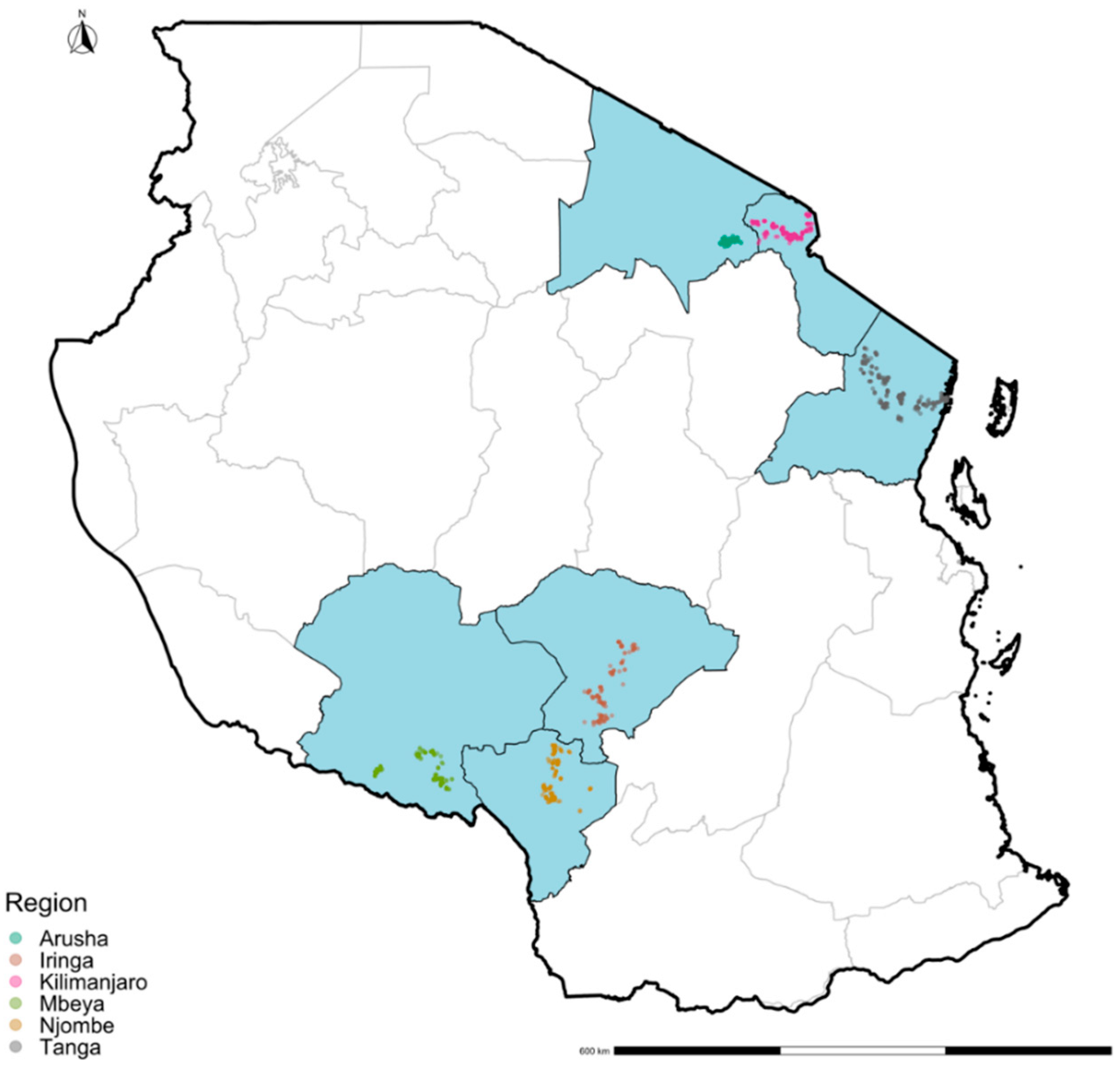
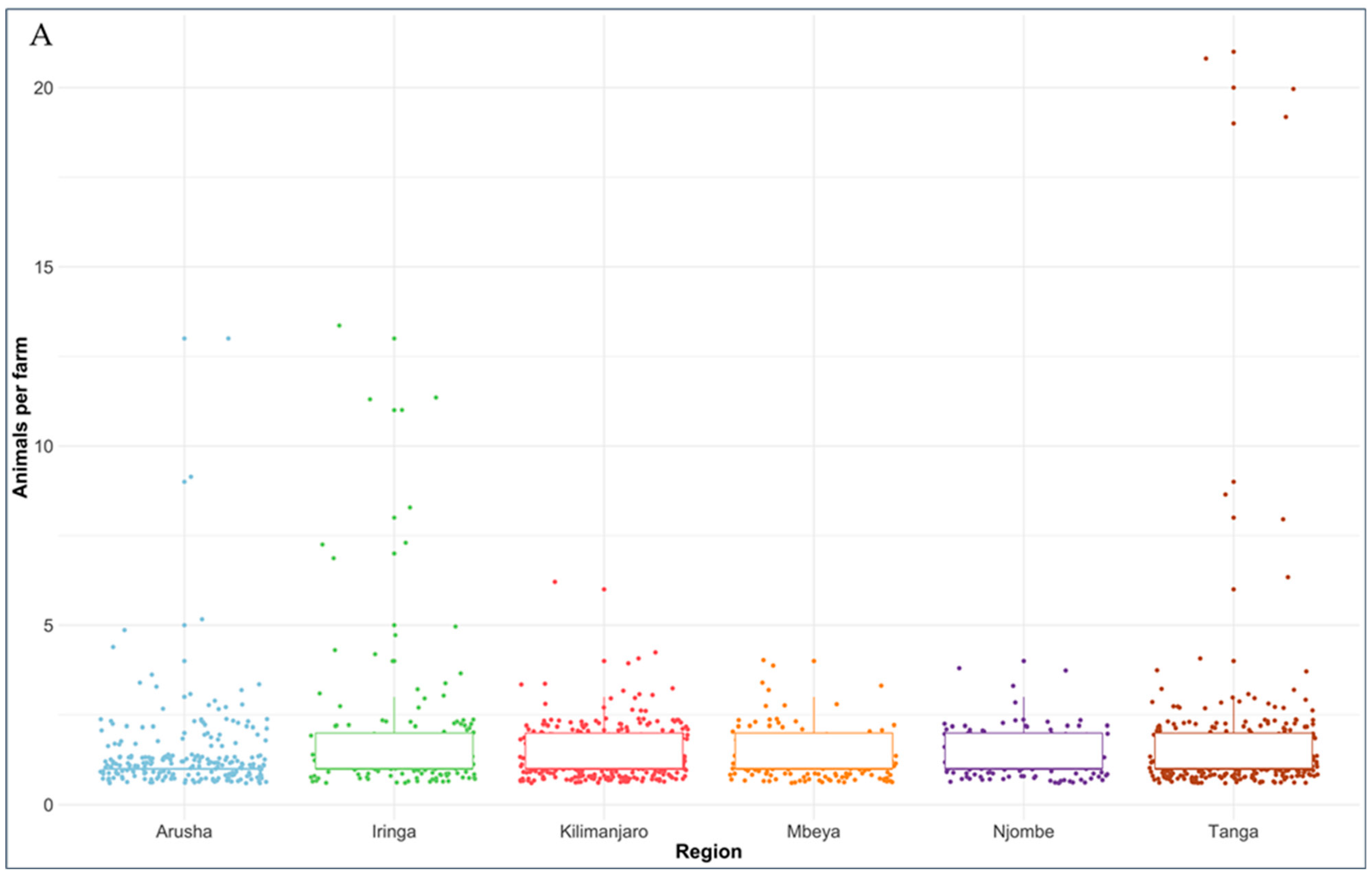
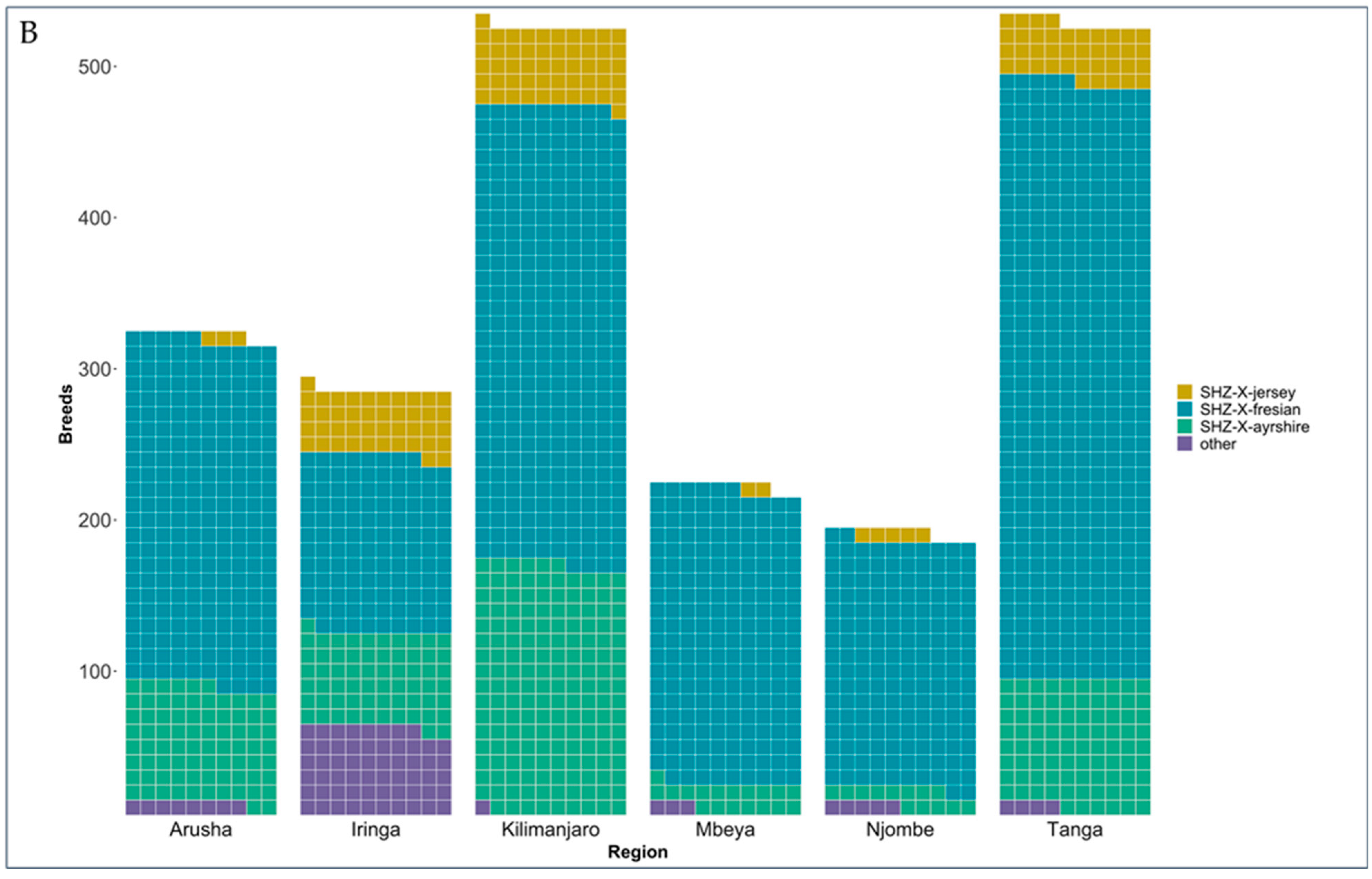

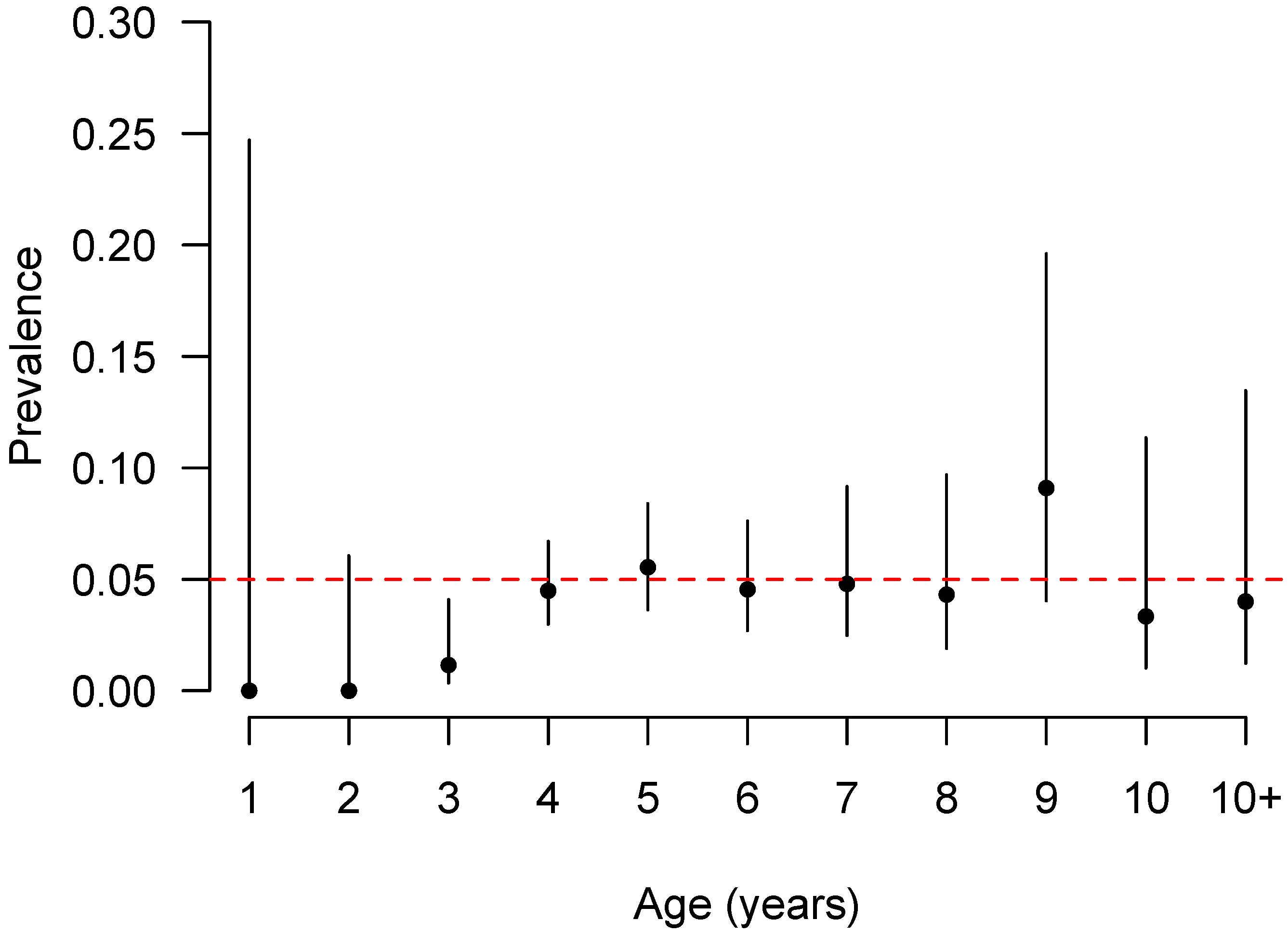
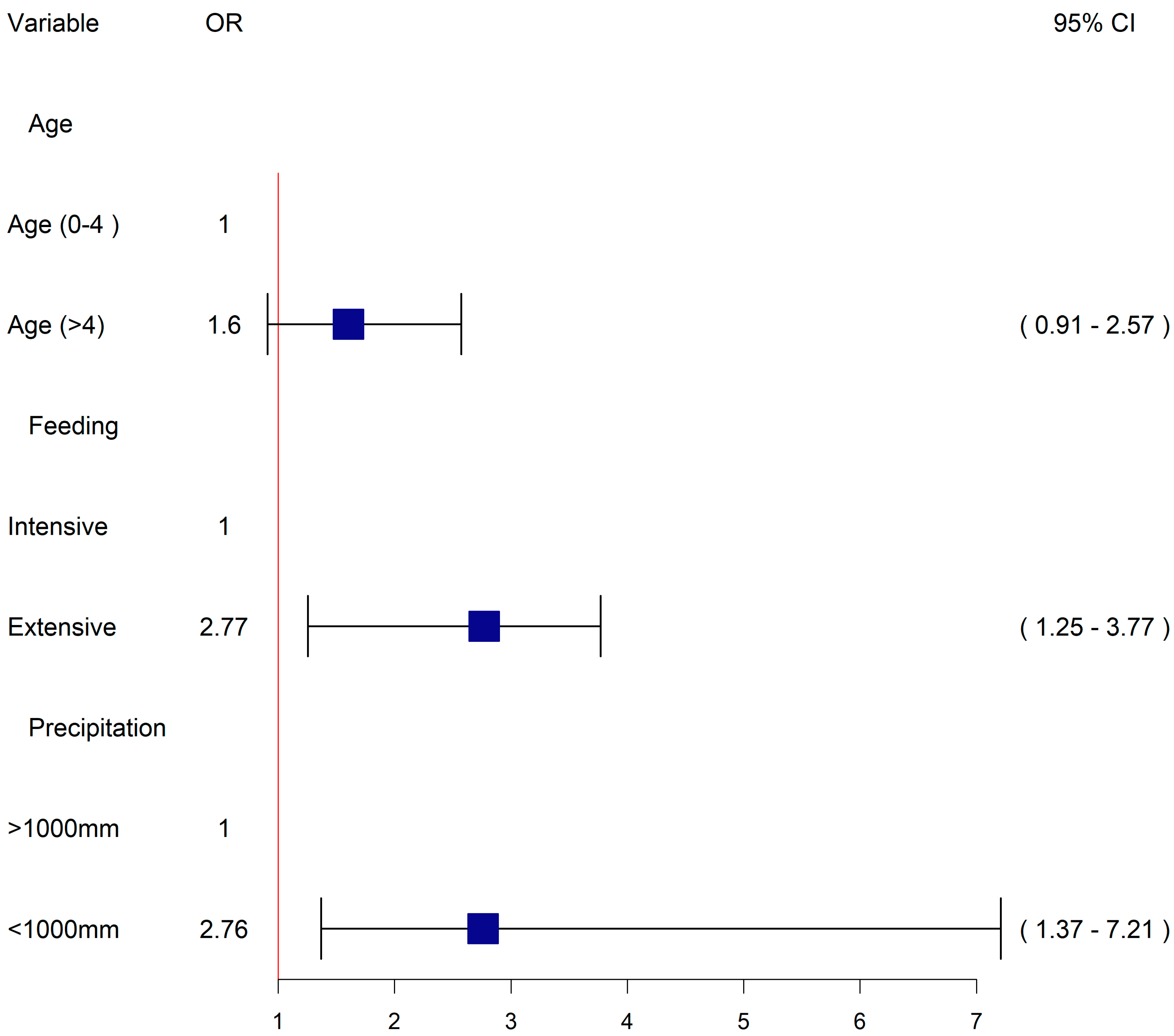
| Region | − | + | Total | Seroprevalence% | 95% CI | Pops | Weights |
|---|---|---|---|---|---|---|---|
| Arusha | 314 | 4 | 318 | 1.26 | 0.34–3.12 | 78,637 | 247 |
| Tanga | 481 | 43 | 524 | 8.21 | 6.0–10.89 | 41,639 | 79 |
| Kilimanjaro | 505 | 16 | 521 | 3.07 | 1.77–4.94 | 161,984 | 311 |
| Mbeya | 218 | 0 | 218 | 0 | 0.0–1.68 | 72,724 | 334 |
| Njombe | 184 | 3 | 187 | 1.60 | 0.33–4.62 | 7177 | 38 |
| Iringa | 268 | 13 | 281 | 4.63 | 2.49–7.78 | 7081 | 25 |
| Total | 1970 | 79 | 2049 | 3.86 | 3.06–4.78 | 369,242 |
| Variables | Levels | Negative | Positive | OR | 95% CI | p Value |
|---|---|---|---|---|---|---|
| Animal related variables | ||||||
| Age | 0–4 Years old | 742 | 24 | 1 | ||
| >4 Years old | 1228 | 55 | 1.38 | 0.85–2.25 | 0.24 | |
| Animal sex | Male | 57 | 1 | 1 | ||
| Female | 1913 | 78 | 2.31 | 0.31–16.89 | 0.72 | |
| Breed type | Cross-bred | 1895 | 75 | 1 | ||
| Indigenous | 75 | 4 | 1.33 | 0.47–3.74 | 0.55 | |
| Herd related variables | ||||||
| Presence of rodents | No | 127 | 1 | 1 | ||
| Yes | 1843 | 78 | 5.44 | 0.75–39.43 | 0.05 | |
| Keeping dogs | No | 229 | 6 | 1 | ||
| Yes | 1741 | 73 | 1.62 | 0.7–3.77 | 0.37 | |
| Keeping cats | No | 172 | 10 | 1 | ||
| Yes | 1798 | 69 | 0.67 | 0.34–1.32 | 0.23 | |
| Keeping goats | No | 648 | 24 | 1 | ||
| Yes | 1322 | 55 | 1.14 | 0.7–1.86 | 0.63 | |
| Keeping sheep | No | 1482 | 65 | 1 | ||
| Yes | 488 | 14 | 0.65 | 0.36–1.17 | 0.18 | |
| Keeping pigs | No Yes | 905 1065 | 46 33 | 1 0.62 | 0.39–0.98 | 0.04 |
| Farm management related variables | ||||||
| Herd size | 1–3 | 1280 | 38 | 1 | ||
| >3 | 690 | 41 | 2.00 | 1.28–3.14 | <0.01 | |
| Own bull for breeding | Yes | 522 | 17 | 1 | ||
| No | 1448 | 62 | 1.32 | 0.76–2.27 | 0.36 | |
| Water source | Tap | 1253 | 55 | 1 | ||
| Ground | 717 | 24 | 0.76 | 0.47–1.24 | 0.34 | |
| Feeding management | Intensive system | 1489 | 44 | 1 | ||
| Extensive system | 481 | 35 | 2.43 | 1.54–3.83 | <0.01 | |
| Placenta disposal | 5 | 0 | 1 | |||
| Destroy Environment | 1975 | 79 | 0.45 | 0.02–8.21 | 1 | |
| Location related variables | ||||||
| Region | Southern Highlands | 671 | 16 | 1 | ||
| Northern Zone | 1299 | 63 | 2.03 | 1.17–3.55 | 0.01 | |
| Distance to next farm | >100 M | 509 | 23 | 1 | ||
| <100 M | 1461 | 56 | 0.86 | 0.52–1.41 | 0.60 | |
| Environmental related variables | ||||||
| Temperature | ≤20 °C on average annually | 1359 | 30 | 1 | ||
| >20 °C on average annually | 611 | 49 | 3.63 | 2.28–5.78 | <0.01 | |
| Precipitation | >1000 mm on average annually ≤1000 mm on average annually | 1637 333 | 60 19 | 1 1.56 | 0.92–2.64 | 0.13 |
| Wind speed | ≤7 Km/h | 1092 | 35 | 1 | ||
| >7 Km/h | 876 | 44 | 1.54 | 0.98–2.42 | 0.07 | |
| Solar radiation | ≤5 W/m2 >5 W/m2 | 450 1520 | 9 70 | 1 2.34 | 1.16–4.71 | 0.01 |
| Model | Model Formula | AIC | ||||||
|---|---|---|---|---|---|---|---|---|
| Q fever elisa~Age + Sex + Keeping cats + Keeping sheep + | ||||||||
| Wind speed + Keeping pigs + Herd size + Feeding management + Breed + | ||||||||
| 1 | Temperature + Precipitation + Solar radiation + (1|district) | 625.41 | ||||||
| Wind speed + Keeping pigs + Herd size + Feeding management+ | ||||||||
| 2 | Temperature + Precipitation + Solar radiation + (1|district) | 623.54 | ||||||
| Wind speed + Herd size + Feeding management + Temperature+ | ||||||||
| 3 | Precipitation + Solar radiation + (1|district) | 621.73 | ||||||
| Q fever elisa~Age + Sex + Keeping cats + Keeping sheep + | ||||||||
| Wind speed + Herd size + Feeding management + Temperature+ | ||||||||
| 4 | Precipitation + (1|district) | 619.85 | ||||||
| Q fever elisa ~ Age + Sex + Keeping cats + Keeping sheep + | ||||||||
| Herd size + Feeding management + Temperature + Precipitation | ||||||||
| 5 | + (1|district) | 617.96 | ||||||
| Q fever elisa~Age + Sex + Keeping cats + Herd size | ||||||||
| 6 | + Feeding management + Temperature + Precipitation + (1|district) | 616.4 | ||||||
| Q fever elisa~Age + Sex + Keeping cats + Feeding management | ||||||||
| 7 | + Temperature + Precipitation + (1|district) | 614.76 | ||||||
| Q fever elisa~Age + Sex + Feeding management | ||||||||
| 8 | + Temperature + Precipitation + (1|district) | 613.63 | ||||||
| Q fever elisa~Age + Feeding management + Temperature | ||||||||
| 9 | + Precipitation + (1|district) | 613.52 | ||||||
| Q fever elisa~Age + Feeding management + Precipitation | ||||||||
| 10 | + (1|district) | 613.09 | ||||||
Publisher’s Note: MDPI stays neutral with regard to jurisdictional claims in published maps and institutional affiliations. |
© 2022 by the authors. Licensee MDPI, Basel, Switzerland. This article is an open access article distributed under the terms and conditions of the Creative Commons Attribution (CC BY) license (https://creativecommons.org/licenses/by/4.0/).
Share and Cite
Bwatota, S.F.; Shirima, G.M.; Hernandez-Castro, L.E.; Bronsvoort, B.M.d.C.; Wheelhouse, N.; Mengele, I.J.; Motto, S.K.; Komwihangilo, D.M.; Lyatuu, E.; Cook, E.A.J. Seroprevalence and Risk Factors for Q fever (Coxiella burnetii) Exposure in Smallholder Dairy Cattle in Tanzania. Vet. Sci. 2022, 9, 662. https://doi.org/10.3390/vetsci9120662
Bwatota SF, Shirima GM, Hernandez-Castro LE, Bronsvoort BMdC, Wheelhouse N, Mengele IJ, Motto SK, Komwihangilo DM, Lyatuu E, Cook EAJ. Seroprevalence and Risk Factors for Q fever (Coxiella burnetii) Exposure in Smallholder Dairy Cattle in Tanzania. Veterinary Sciences. 2022; 9(12):662. https://doi.org/10.3390/vetsci9120662
Chicago/Turabian StyleBwatota, Shedrack Festo, Gabriel Mkilema Shirima, Luis E. Hernandez-Castro, Barend Mark de Clare Bronsvoort, Nick Wheelhouse, Isaac Joseph Mengele, Shabani Kiyabo Motto, Daniel Mushumbusi Komwihangilo, Eliamoni Lyatuu, and Elizabeth Anne Jessie Cook. 2022. "Seroprevalence and Risk Factors for Q fever (Coxiella burnetii) Exposure in Smallholder Dairy Cattle in Tanzania" Veterinary Sciences 9, no. 12: 662. https://doi.org/10.3390/vetsci9120662
APA StyleBwatota, S. F., Shirima, G. M., Hernandez-Castro, L. E., Bronsvoort, B. M. d. C., Wheelhouse, N., Mengele, I. J., Motto, S. K., Komwihangilo, D. M., Lyatuu, E., & Cook, E. A. J. (2022). Seroprevalence and Risk Factors for Q fever (Coxiella burnetii) Exposure in Smallholder Dairy Cattle in Tanzania. Veterinary Sciences, 9(12), 662. https://doi.org/10.3390/vetsci9120662






